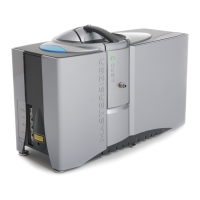Viewing measurement results Chapter 5
Mastersizer 3000 Page 5-13
L
s
is the light intensity measured in the central detector when a sample is pre-
sent in the cell, L
b
is the same but with clean dispersant (i.e. with no sample).
Obscuration is usually expressed as a percentage: 100 x Ob.
An ideal range is between 3 and 20%, depending on the sample and dispersion
unit used.
Distribution – shows the type of distribution the analysis has used. Options
include change from volume to surface area, length or number. Remember
that the Mastersizer measurement is fundamentally a measurement of the vol-
ume distribution - transforming the result into a surface, length or number dis-
tribution is a mathematical process that may amplify any error in the original
result, especially at the fine end of the size distribution.
Uniformity – a measure of the absolute deviation from the median.
Here d(x,0.5) is the median size of the distribution (where x is replaced by v, s,
l or n) and d
i
and x
i
are respectively the mean diameter o f, and result in, size
class i.
Specific Surface Area (SSA) – the total area of the particles divided by the
total weight.
where V
i
is the relative volume in class i with mean class diameter of d
i
and p is
the particle density.
If the SSA is used, it is important that the density of the material is defined (in
the SOP’s Material settings). This figure is a mathematical calculation based
on the assumption that the particles are both spherical and non-porous.
Uniformity
X
i
dx0.5d
i
–
dx0.5X
i
------------------------------------------------
=
SSA
6
V
i
d
i
-----
pV
i
----------------
6
pD 32
---------------------
==

